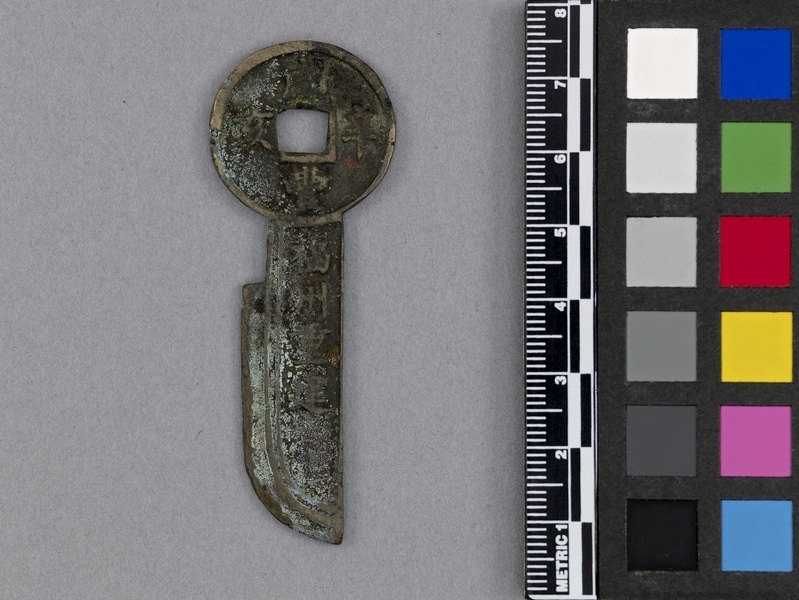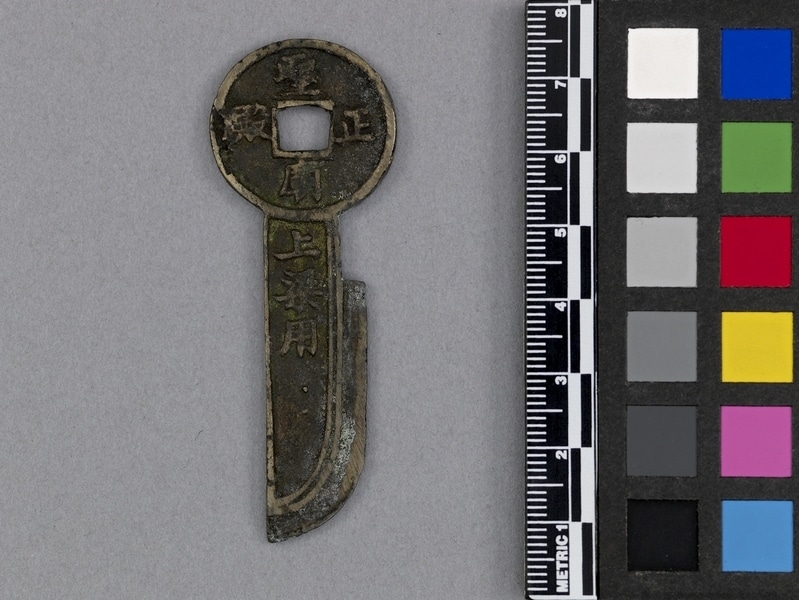Charm Item Number: Edz4181 from the MOA: University of British Columbia


Description
Knife money shaped charm with a Chinese coin-like circle at the top, characters on the blade, and inner and outer rims on both sides. On one side, there are four seal script characters on the round portion, and four seal script characters on the blade. On the reverse, there are four seal script characters on the round portion, and three seal script characters on the blade.
History Of Use
Design similar to a coin, but not for circulation; not from the period it purports to be from (Larson, David). The tradition of using commemorative coins for the beam installation ceremony of a construction project was often practiced for palaces and temples. The design of this coin was copied after an archaistic knife coin issued duringWang Mang's first currency reform in A.D. 7, which, in turn, was aimed at reintroducing the archaic monetary system of the Zhou Dynasty (11th to 3rd century B.C.), thought to be the "Golden Age" according to Confucian values. Therefore, the shape resembles the currency form that was attributed to be contemporary with the time of Confucius (during his historical period). Spade-shaped coins were also issued for the Confucian shrine ceremony, which bore the exact time and date of the ceremony (Cai, 1989, 258). The Confucian shrine was a place for literati to pay tribute to Confucius, the ultimate icon of Chinese intellectuals and students of imperial civil service examinations (Li, Min).
Iconographic Meaning
The coin's shape symbolizes Confucian values.
Narrative
A key-shaped coin was used for the beam-installation ceremony during the reconstruction of the main hall at the Confucian shrine in Fuzhou in 1851, the first year of Xianfeng reign. On December 4, 1851, an enormous ceremony was held for the ceremony in the main hall of the shrine, marking completion of its reconstruction. These special commemorative coins may have been deposited in a cache carved inside the beam to be raised.
Item History
- Made in China during 1851
- Collected between 1893 and 1911
- Owned by Colin Campbell Brown
- Owned by Hugh Campbell Brown before February 1, 1961
- Received from Hugh Campbell Brown (Donor) on February 1, 1961
What
- Name
- Charm
- Identification Number
- Edz4181
- Type of Item
- charm
- Material
- brass metal
- Manufacturing Technique
- cast and filed
- Overall
- height 0.3 cm, width 6.9 cm, depth 2.8 cm, weight 0.524 oz
Who
- Culture
- Chinese
- Previous Owner
- Colin Campbell Brown and Hugh Campbell Brown
- Received from
- Hugh Campbell Brown (Donor)
Where
- Holding Institution
- MOA: University of British Columbia
- Made in
- China
When
- Creation Date
- during 1851
- Collection Date
- between 1893 and 1911
- Ownership Date
- before February 1, 1961
- Acquisition Date
- on February 1, 1961
Other
- Item Classes
- metalwork
- Condition
- poor
- Accession Number
- 0042/0071 b